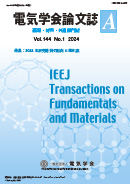
- |<
- <
- 1
- >
- >|
-
Shoho Ando, Koki Koyanagi, Ryuta Ichiki, Takefumi Otsu, Takashi Furuki ...2024Volume 144Issue 5 Pages 159-164
Published: May 01, 2024
Released on J-STAGE: May 01, 2024
JOURNAL RESTRICTED ACCESSWe performed the ball-on-disk tribological test for tool steels nitrided by the atmospheric-pressure pulsed-arc plasma jet to investigate improvement of the wear resistance. The test with an alumina ball proved that the plasma-jet nitriding decreases the wear rate approximately by half. Moreover, the friction coefficient, as well as the wear rate, is reduced drastically when the compound layer has been formed on the outermost steel surface. In addition, we examined the tribological properties of the locally oxidized spot undesirably formed on the steel surface during the relevant nitriding treatment. As a result, the oxidized spot can be readily removed in a few minutes even by relatively a small load.
View full abstractDownload PDF (1643K) -
Rentaro Sayo, Takashi Todaka, Takeru Sato, Tsukuru Kinoshita2024Volume 144Issue 5 Pages 165-170
Published: May 01, 2024
Released on J-STAGE: May 01, 2024
JOURNAL RESTRICTED ACCESSIn order to reduce power consumption, research is being actively conducted to reduce iron losses of electrical steel sheets, which are the common core material of electric motors. Semi processed materials usually need to be annealed after forming into motor cores, and applying rapid heating is expected to significantly improve their magnetic properties. In this study, we focused on use of induction heating techniques, which enable short annealing time, and investigated the annealing effect on semi processed materials. In this paper, a low frequency induction heating annealing was applied to the semi processed materials, and it was shown that the magnetic property was improved by annealing at high temperature during short annealing period.
View full abstractDownload PDF (1785K) -
Kyonosuke Ito, Takeru Sato, Takashi Todaka2024Volume 144Issue 5 Pages 171-175
Published: May 01, 2024
Released on J-STAGE: May 01, 2024
JOURNAL RESTRICTED ACCESSHeat treatment in a magnetic field is necessary to improve magnetic properties of the Fe-based amorphous magnetic materials (Fe-Si-B). In this paper, we proposed a magnetic-field annealing method with SmCo permanent magnets for the purpose of heat-treating amorphous cores in various shapes. As a basic study, for a 10 mm × 60 mm strip-shaped samples, the magnetic-field annealing was conducted in an electric furnace, and the magnetic properties before and after heat treatment were compared with those of a conventional method with an electromagnet. Magnetic measurements were performed by using a small-sized single-sheet-tester (S-SST). The results showed that the magnetic properties after heat treatment with the permanent magnets can be improved as well as those with the conventional electromagnet method. This paper clarified issues to be solved for further improvement of the proposed method with permanent magnets.
View full abstractDownload PDF (909K) -
Nobutaka Araoka, Norimitsu Takamura, Tsubasa Inoue, Masahiro Hanai2024Volume 144Issue 5 Pages 176-182
Published: May 01, 2024
Released on J-STAGE: May 01, 2024
JOURNAL RESTRICTED ACCESSWe investigated AC breakdown characteristics of ultra violet curable epoxy resin (UV-EP) with nitrogen fine bubbles (FBs) in order to improve insulating properties of UV-EP. As a result, it was found that self-made FB generator mainly add FBs with a diameter between 60 and 150 nm to FB-EP before curing. In addition, SEM images revealed that FB-EP has FBs after curing. Bubble diameter in FB-EP after curing was estimated between 55 and 140 nm due to resin shrinkage. Furthermore, partial discharge inception voltage and electric strength of FB-EP with FB addition for 10 minutes were almost the same as No FB-EP.
View full abstractDownload PDF (1380K)
-
Hiroto Yokoyama, Hajime Shimakawa, Akiko Kumada, Masahiro Sato2024Volume 144Issue 5 Pages 183-184
Published: May 01, 2024
Released on J-STAGE: May 01, 2024
JOURNAL RESTRICTED ACCESSUnderstanding thermal conduction mechanism in polymer insulating materials is crucial for the development of insulating materials with high thermal conductivity (TC). This paper reveals the difference in thermal conduction between crystalline and amorphous polyethylene (PE) from an atomistic point of view. The results imply that the strength of the bond angle is most influential on the TC of crystalline PE, while the depth of the Lennard-Jones potential has a significant influence on that of amorphous PE. The method proposed in this paper can clarify the relationship between molecular structure and TC, offering guidelines for molecular design.
View full abstractDownload PDF (715K)
-
2024Volume 144Issue 5 Pages NL5_1-NL5_5
Published: May 01, 2024
Released on J-STAGE: May 01, 2024
JOURNAL FREE ACCESSDownload PDF (906K) -
[in Japanese]2024Volume 144Issue 5 Pages NL5_6
Published: May 01, 2024
Released on J-STAGE: May 01, 2024
JOURNAL FREE ACCESSDownload PDF (728K)
-
2024Volume 144Issue 5 Pages L5_1
Published: May 01, 2024
Released on J-STAGE: May 01, 2024
JOURNAL FREE ACCESSDownload PDF (151K)
- |<
- <
- 1
- >
- >|